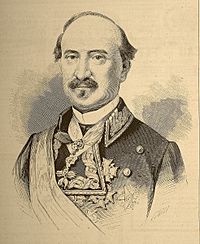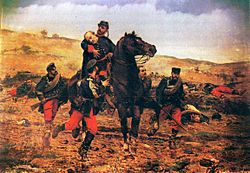Manuel Gutiérrez de la Concha, Marquis of the Duero facts for kids
Quick facts for kids
The Marquis of the Duero
|
|
|---|---|

19th Century litography
|
|
| Born | April 3, 1808 Córdoba (Argentina) |
| Died | June 27, 1874 (aged 66) Monte Muro, Navarre, Spain |
| Buried | |
| Allegiance | Spanish government in opposing the Carlists |
| Rank | General, Captain-general, corps commander |
| Commands held | Third Corps of the Army of the North (1874) |
| Battles | Durango, Urrieta, Belascoáin, Arróniz, Bilbao, Monte Muro |
| Awards | Cross of San Fernando (three times) |
| Spouse(s) | Francisca de Paula Tovar y Gasca |
Manuel Gutiérrez de la Concha e Irigoyen, Marquis of the Duero, was an important Spanish soldier and politician in the 1800s. He was known for fighting against groups called the Carlists. He was born in Córdoba, Argentina on April 3, 1808. He died in Navarre, Spain, on June 27, 1874.
Contents
Early Life and Military Career
Manuel de la Concha was born in what is now Argentina. His father was a naval officer and governor. Sadly, his father died in a conflict in 1810. In 1814, Manuel's family moved to Spain.
He started his military training in 1820. He quickly rose through the ranks. By 1832, he was a lieutenant.
Supporting the Liberals
Manuel supported the Liberals. This group wanted more freedom and changes in Spain. Because of his beliefs, he was put in prison for a few months.
He was released during the First Carlist War. This was a big war in Spain. Manuel joined the side that supported Queen Isabella II. He showed great bravery in battles like Durango and Alsasua. He even received a special award called the Cross of San Fernando.
He continued to earn promotions. After a battle at Urrieta, he became a lieutenant-colonel. Another battle, Belascoáin, earned him a second Cross of San Fernando. He became a mariscal de campo, a very high military rank, in 1840. He won a third Cross of San Fernando in the Arróniz campaign.
Rise to General
Manuel supported the Moderate political party. In 1841, he became the commanding general for two provinces.
In 1841, he tried to help end the rule of General Espartero. This attempt failed, and Manuel had to leave Spain. He lived in Florence, Italy, for a while.
In 1843, he helped bring down Espartero's rule. This earned him a promotion to lieutenant-general. The Moderates, now in power, made him the chief inspector of the infantry. Later, he became the top military commander, or captain-general, of Old Castile.
International Missions and Honors
In 1847, Manuel led an army to Portugal. His mission was to help Queen Maria II of Portugal keep her throne. He defeated rebel forces in Oporto. This helped restore the Queen's power.
For his success, he received many honors. He was given the title Marquis of the Duero. He also became a Grandee of the first class, a very high noble rank in Spain.
As captain-general of Catalonia, he stopped a revolt in 1849. This happened during the Second Carlist War.
Political Influence
Manuel worked with General Leopoldo O'Donnell in the mid-1850s. He served as a deputy in the Spanish parliament, called the Cortes. He also chaired an important war council.
He was captain-general of the Two Castiles during the Unión Liberal government. In the 1860s, he served as Speaker of the Senate for five terms.
Final Battle and Legacy
The Third Carlist War began in 1872. Even though he was older, Manuel returned to military service. He was a strong supporter of Alfonso XII of Spain. He was considered one of Spain's best military strategists.
In 1874, the government gave him command of the Third Corps of the Army of the North. This unit was key to defending the country. He led the fight against the Carlists in the north. He won important victories, including freeing the city of Bilbao in May.
Manuel was preparing for an attack on Estella, the Carlist capital. On June 27, 1874, he was fatally wounded by a bullet. This happened at Monte Muro, near Abárzuza.
Manuel Gutiérrez de la Concha was a brilliant military leader. He wrote a book called Tactics of the Three Forces in 1862. This book was highly respected at the time.
San Pedro Alcántara Settlement
Manuel Gutiérrez de la Concha was married to Francisca de Paula Tovar y Gasca. She owned many farms and country estates. On one of these estates near Málaga, the Marquis improved the sugar cane crops. This inspired him to start new farming projects.
In the late 1850s, he began buying land on the western coast of Málaga. He used special laws that encouraged rural development. He created a large farming settlement called San Pedro Alcántara. This is where the modern village is today.
The settlement was huge, about 5,000 hectares. It included land around Marbella, Benahavís, and Estepona. Manuel brought in the newest farming methods and machines. He also built a training farm and a modern sugar processing plant.
Images for kids
-
Mausoleum of the Marquess of Duero at the Pantheon of Illustrious Men, Madrid
See also
 In Spanish: Manuel Gutiérrez de la Concha e Irigoyen para niños
In Spanish: Manuel Gutiérrez de la Concha e Irigoyen para niños




